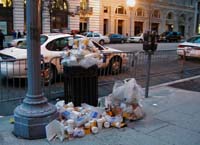
|
|
|
Politics
Main Page |
| Cleanup
Crews Undo Weeks of Inaugural Planning in Wee Hours of Morning
By Kathleen Cullinan WASHINGTON - When the inaugural balls officially ended at 1 a.m. and revelers all around Washington headed for bed, crews that were taking more than 100 tractor-trailers of sets and parade floats home to Lanham were just getting into gear. The massive cleanup is the less talked about side of staging an inaugural, a task that has fallen to Maryland-based special events company, Hargrove, every four years since Harry Truman took office in 1949. Some of the Hargrove staff had already put in 40 hours straight of intense inaugural work when the cleanup began early Friday. "I kind of hit a wall at about 2 in the morning," said Marvin Bond, a spokesman for Hargrove. By 11 a.m. Friday, he said, the company's Lanham office was still quiet as workers trickled in. Hargrove workers were not the only ones scrambling to clean up the remains of the inaugural in the wee hours Friday. At Union Station, where the Freedom Ball was held Thursday night, train commuters filed in at 5 a.m. Friday just as the last party equipment was loaded into trucks, said Michele Jacobs, who helped organize that event. City workers swept through after the parade and had the streets cleaned by Friday, said D.C. Department of Public Works spokeswoman Mary Myers. The stands where the president sat at the Capitol will take about three weeks to dismantle, said a spokeswoman with the Architect of the Capitol. Porta-johns on the Mall were being stacked up for removal Friday afternoon. For Hargrove, the breakdown undid the weeks of virtually nonstop work needed to plan and stage nine balls, six parade floats, three candlelit dinners and more than 20 other private events. "It's really more like 30 jobs or 35 jobs," Bond said, adding that the inaugural week is "planned out like a military campaign." This year, the company had to design specially color-coded signs in addition to the standard stages and floats. By the time the president took the oath Thursday, Bond said, Hargrove's army of 200 employees had been working around the clock for four days. "Everybody does something they don't normally do" to help the company prepare, Bond said, even if that means fluffing fabric. "It's a unique experience." But "you always have hitches," said Bond. The 36-foot eagle the company built never even had a chance to soar: High winds damaged its wings, leaving it unfit for flight down the parade route. "In the end, it all comes together. You get the job done and it looks great," Bond said. Then comes the cleanup. Before the balls even opened, Hargrove workers took apart the floats and trucked them under police escort back to Lanham, a process that continued well after the balls were over. Hargrove still has its hands full, even as the 2005 inauguration becomes history. Last year, it worked on the opening of the World War II memorial, on the G-8 summit in Savannah, Ga., and on Ronald Reagan's funeral in a three-week span. But nothing carries the lore of supplying an inaugural every four years, Bond said. "It becomes sort of bookends, like the chapters of the company's history," he said.
Copyright ©
2005 University of Maryland Philip Merrill College of
Journalism
|

